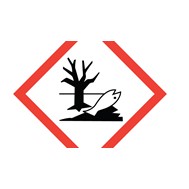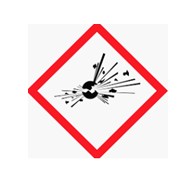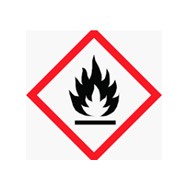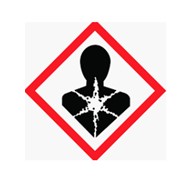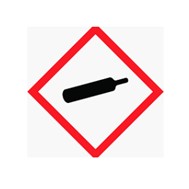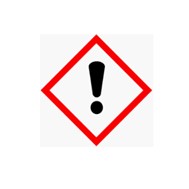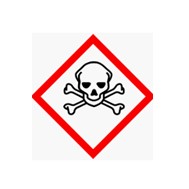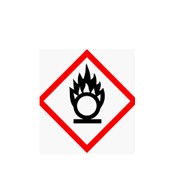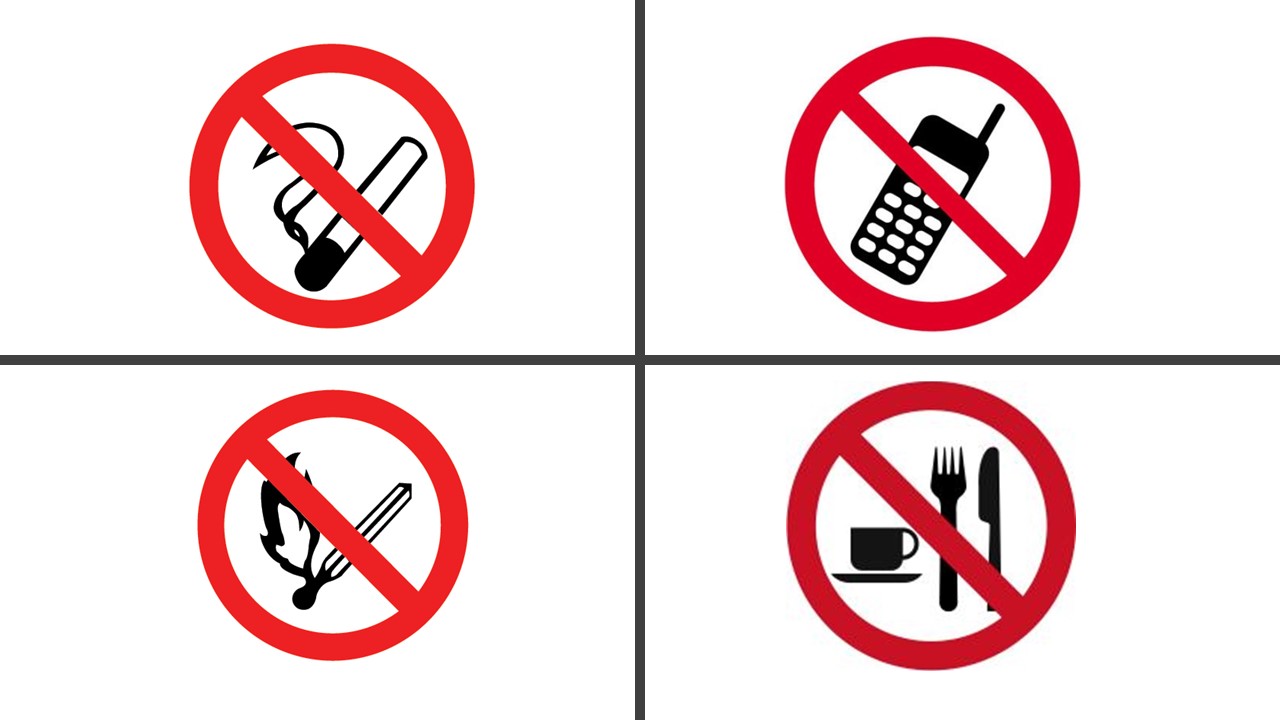Title Page
-
Business unit
- No Environmental hazards apply to this chemical
- H400 Very toxic to aquatic life
- H401 Toxic to aquatic life
- H402 Harmful to aquatic life
- H410 Very toxic to aquatic lift with long lasting effects
- H411 Toxic to aquatic life with long lasting effects
- H412 Harmful to aquatic life with long lasting effects
- H413 May cause long lasting harmful effects to aquatic life
- H420 Harms public health and the environment by destroying ozone in the upper atmosphere
-
Ref No.
-
Task Name:
-
Chemical Name (s)
-
Are Safety Data Sheets available?
-
Image of chemical container
-
Prepared by
Chemical Information
-
Hazard ID
- Corrosive
- Environmental Hazard
- Explosive
- Flammable
- Compressed Gas
- Health Hazard
- Caution/Danger
- Oxidiser
- Toxic
- No Hazards Applicable
-
Corrosive to metals and can cause severe skin burns and eye damage.
-
Toxic to aquatic life with lasting effects
-
Explosives may explode in fire/heat together with risk of projectiles.
-
Flammable gasses, aerosols, liquid, vapours and solids.
-
Severe Health hazards and may cause repiratory issues, dizziness and skin/reactions. Can be harmful if swallowed/inhaled or contact with skin.
-
Compressed gasses may explode if heated with projectile/fire risk. Refrigerated gasses may cause cold burns/injuries.
-
Health hazards and may cause repiratory issues, dizziness and skin/reactions. Can be harmful if swallowed/inhaled or contact with skin.
-
Toxic/Fatal if swallowed, inhaled and contact with skin
-
Oxiders may cause or intensify fire and can explode.
H Codes
-
H codes (Physical Hazards)
- No physical hazard associated with this chemical
- H200: Unstable explosive
- H201: Explosive; mass explosion hazard
- H202: Explosive; severe projection hazard
- H203: Explosive; fire, blast or projection hazard
- H204: Fire or projection hazard
- H205: May mass explode in fire
- H206: Fire, blast or projection hazard; increased risk of explosion if desensitising agent is reduced.
- H207: Fire or projection hazard; increased risk of explosion if desensitising agent is reduced.
- H208: Fire hazard; increased risk of explosion if desensitising agent is reduced.
- H220: Extremely flammable gas
- H221: Flammable gas
- H222: Extremely flammable material
- H223: Flammable material
- H224: Extremely flammable liquid and vapour
- H225: Highly flammable liquid and vapour
- H226: Flammable liquid and vapour
- H227: Combustible liquid
- H228: Flammable solid
- H229: Pressurized container: May burst if heated
- H230: May react explosively even in the absence of air
- H231: May react explosively even in the absence of air at elevated pressure and/or temperature
- H232: May ignite spontaneously if exposed to air
- H240: Heating may cause an explosion
- H241: Heating may cause a fire or explosion
- H242: Heating may cause a fire
- H250: Catches fire spontaneously if exposed to air
- H251: Self-heating; may catch fire
- H252: Self-heating in large quantities; may catch fire
- H260: In contact with water releases flammable gases which may ignite spontaneously
- H261: In contact with water releases flammable gas
- H270: May cause or intensify fire; oxidizer
- H271: May cause fire or explosion; strong oxidizer
- H272: May intensify fire; oxidizer
- H280: Contains gas under pressure; may explode if heated
- H281: Contains refrigerated gas; may cause cryogenic burns or injury
- H290: May be corrosive to metals
-
H Codes (Health Hazards)
- No health hazards apply to this chemical
- H300: Fatal if swallowed
- H301: Toxic if swallowed
- H302: Harmful if swallowed
- H303: May be harmful if swallowed
- H304: May be fatla if swallowed and enters airways
- H305: May be harmful if swallowed and enters airways
- H310: Fatal in contact with skin
- H311: Toxic in contact with skin
- H312: Harmful in contact with skin
- H313: May be harmful in contact with skin
- H314: Causes severe skin burns and eye damage
- H315: Causes skin irritation
- H316: Causes mild skin irritation
- H317: May cause an allergic skin reaction
- H318: Causes serious eye damage
- H319: Causes serious eye irritation
- H320: Causes eye irritation
- H330: Fatal if inhaled
- H331: Toxic if inhaled
- H332: Harmful if inhaled
- H333: May be harmful if inhaled.
- H334: May cause allergy or asthma symptoms or breathing difficulties if inhaled.
- H335: May cause respiratory irritation
- H336: May cause drowsiness or dizziness
- H340: May cause genetic defects
- H341: Suspected of causing genetic defects
- H350: May cause cancer
- H351: Suspected of causing cancer
- H350i: May cause cancer by inhalation
- H360: May damage fertility or unborn child
- H361: Suspected of damaging fertility or the unborn child
- H361d: Suspected of damaging fertility or the unborn child
- H360f: May damage fertility.
- H362: May cause harm to breast-fed children
- H370: Causes damage to organs
- H371: May cause damage to organs
- H372: Causes damage to organs through prolonged or repeated exposure
- H373: May cause damage to organs through prolonged or repeated exposure
-
H Codes (Environmental Hazards)
- No Environmental hazards apply to this chemical
- H400 Very toxic to aquatic life
- H401 Toxic to aquatic life
- H402 Harmful to aquatic life
- H410 Very toxic to aquatic lift with long lasting effects
- H411 Toxic to aquatic life with long lasting effects
- H412 Harmful to aquatic life with long lasting effects
- H413 May cause long lasting harmful effects to aquatic life
- H420 Harms public health and the environment by destroying ozone in the upper atmosphere
P Codes
-
Precautionary Statement codes
- P101 - If medical advice is needed, have product container or label at hand.
- P102 - Keep out of reach of children.
- P103 - Read label before use.
- P201 - Obtain special instructions before use.
- P202 - Do not handle until all safety precautions have been read and understood.
- P210 - Keep away from heat/sparks/open flames/hot surfaces. - No smoking.
- P211- Do not spray on an open flame or other ignition source.
- P220 - Keep/Store away from clothing/.../combustible materials.
- P221 - Take any precaution to avoid mixing with combustibles...
- P222- Do not allow contact with air.
- P223 - Keep away from any possible contact with water, because of violent reaction and possible flash fire.
- P230 - Keep wetted with...
- P231 - Handle under inert gas.
- P232 - Protect from moisture.
- P233 - Keep container tightly closed.
- P234 - Keep only in original container.
- P235 - Keep cool.
- P240 - Ground/bond container and receiving equipment.
- P241 - Use explosion-proof electrical/ventilating/lighting/.../equipment.
- P242 - Use only non-sparking tools.
- P243 - Take precautionary measures against static discharge.
- P244 - Keep reduction valves free from grease and oil.
- P250 - Do not subject to grinding/shock/.../friction.
- P251 - Pressurized container: Do not pierce or burn, even after use.
- P260 -Do not breathe dust/fume/gas/mist/vapours/spray.
- P261 - Avoid breathing dust/fume/gas/mist/vapours/spray.
- P262 - Do not get in eyes, on skin, or on clothing.
- P263 - Avoid contact during pregnancy/while nursing.
- P264 - Wash �� thoroughly after handling.
- P270 - Do no eat, drink or smoke when using this product.
- P271 - Use only outdoors or in a well-ventilated area.
- P272 - Contaminated work clothing should not be allowed out of the workplace.
- P273 - Avoid release to the environment.
- P280 - Wear protective gloves/protective clothing/eye protection/face protection.
- P281- Use personal protective equipment as required.
- P282 - Wear cold insulating gloves/face shield/eye protection.
- P283 - Wear fire/flame resistant/retardant clothing.
- P284 - Wear respiratory protection.
- P285 - In case of inadequate ventilation wear respiratory protection.
- P231 + P232 - Handle under inert gas. Protect from moisture.
- P235 + P410 - Keep cool. Protect from sunlight.
- P301 - IF SWALLOWED:
- P302 - IF ON SKIN:
- P303 - IF ON SKIN (or hair):
- P304 - IF INHALED:
- P305 - IF IN EYES:
- P306 - IF ON CLOTHING:
- P307 - IF exposed:
- P308 - IF exposed or concerned:
- P309 - IF exposed or if you feel unwell:
- P310 - Immediately call a POISON CENTER or doctor/physician.
- P311 - Call a POISON CENTER or doctor/physician.
- P312 - Call a POISON CENTER or doctor/physician if you feel unwell.
- P313 - Get medical advice/attention.
- P314 - Get medical advice/attention if you feel unwell.
- P315 - Get immediate medical advice/attention.
- P320 - Specific treatment is urgent (see ... on this label).
- P321 - Specific treatment (see ... on this label).
- P322 - Specific measures (see ... on this label).
- P330 - Rinse mouth.
- P331 - Do NOT induce vomiting.
- P332 - If skin irritation occurs:
- P333 - If skin irritation or rash occurs:
- P334 - Immerse in cool water/wrap in wet bandages.
- P335 - Brush off loose particles from skin.
- P336 - Thaw frosted parts with lukewarm water. Do no rub affected area.
- P337 - If eye irritation persists:
- P338 - Remove contact lenses, if present and easy to do. Continue rinsing.
- P340 - Remove victim to fresh air and keep at rest in a position comfortable for breathing.
- P341 - If breathing is difficult, remove victim to fresh air and keep at rest in a position comfortable for breathing.
- P342 - If experiencing respiratory symptoms:
- P350 - Gently wash with plenty of soap and water.
- P351 - Rinse cautiously with water for several minutes.
- P352 - Wash with plenty of soap and water.
- P353 - Rinse skin with water/shower.
- P360 - Rinse immediately contaminated clothing and skin with plenty of water before removing clothes.
- P361 - Remove/Take off immediately all contaminated clothing.
- P362 - Take off contaminated clothing and wash before reuse.
- P363 - Wash contaminated clothing before reuse.
- P370 - In case of fire:
- P371 - In case of major fire and large quantities:
- P372 - Explosion risk in case of fire.
- P373 - DO NOT fight fire when fire reaches explosives.
- P374 - Fight fire with normal precautions from a reasonable distance.
- P375 - Fight fire remotely due to the risk of explosion.
- P376 - Stop leak if safe to do so.
- P377 - Leaking gas fire: Do not extinguish, unless leak can be stopped safely.
- P378 - Use ... for extinction.
- P380 - Evacuate area.
- P381 - Eliminate all ignition sources if safe to do so.
- P390 - Absorb spillage to prevent material damage.
- P391 - Collect spillage.
- P301 + P310 - IF SWALLOWED: Immediately call a POISON CENTER or doctor/physician.
- P301 + P312 - IF SWALLOWED: Call a POISON CENTER or doctor/physician if you feel unwell.
- P301 +P330 + P331 -IF SWALLOWED: rinse mouth. Do NOT induce vomiting.
- P302 + P334 - IF ON SKIN: Immerse in cool water/wrap in wet bandages.
- P302 + P350 - IF ON SKIN: Gently wash with plenty of soap and water.
- P302 + P352 - IF ON SKIN: Wash with plenty of soap and water.
- P303 + P361 + P353 - IF ON SKIN (or hair): Remove/Take off immediately all contaminated clothing. Rinse skin with water/shower.
- P304 + P340 - IF INHALED: Remove victim to fresh air and keep at rest in a position comfortable for breathing.
- P304 + P341 - IF INHALED: If breathing is difficult, remove victim to fresh air and keep at rest in a position comfortable for breathing.
- P305 + P351 + P338 - IF IN EYES: Rinse cautiously with water for several minutes. Remove contact lenses, if present and easy to do. Continue rinsing.
- P306 + P360 - IF ON CLOTHING: rinse immediately contaminated clothing and skin with plenty of water before removing clothes.
- P307 + P311 - IF exposed: Call a POISON CENTER or doctor/physician.
- P308 + P313 - IF exposed or concerned: Get medical advice/attention.
- P309 + P311 - IF exposed or if you feel unwell: Call a POISON CENTER or doctor/physician.
- P332 + P313 - If skin irritation occurs: Get medical advice/attention.
- P333 + P313 - If skin irritation or rash occurs: Get medical advice/attention.
- P335 + P334 - Brush off loose particles from skin. Immerse in cool water/wrap in wet bandages.
- P337 + P313 - If eye irritation persists: Get medical advice/attention.
- P342 + P311 - If experiencing respiratory symptoms: Call a POISON CENTER or doctor/physician.
- P370 + P376 - In case of fire: Stop leak if safe to do so.
- P370 + P378 - In case of fire: Use ... for extinction.
- P370 + P380 - In case of fire: Evacuate area.
- P370 + P380 + P375 - In case of fire: Evacuate area. Fight fire remotely due to the risk of explosion.
- P371 + P380 + P375 - In case of major fire and large quantities: Evacuate area. Fight fire remotely due to the risk of explosion.
- P401 - Store ...
- P402 - Store in a dry place.
- P403 - Store in a well-ventilated place.
- P404 - Store in a closed container.
- P405 - Store locked up.
- P406 - Store in corrosive resistant/... container with a resistant inner liner.
- P407 - Maintain air gap between stacks/pallets.
- P410 - Protect from sunlight.
- P411 - Store at temperatures not exceeding ... oC/...oF.
- P412 - Do not expose to temperatures exceeding 50 oC/122oF.
- P413 - Store bulk masses greater than ... kg/... lbs at temperatures not exceeding ... oC/...oF.
- P420 - Store away from other materials.
- P422 - Store contents under...
- P402 + P404 - Store in a dry place. Store in a closed container.
- P403 + P233 - Store in a well-ventilated place. Keep container tightly closed.
- P403 + P235 - Store in a well-ventilated place. Keep cool.
- P410 + P403 - Protect from sunlight. Store in a well-ventilated place.
- P410 + P412 - Protect from sunlight. Do no expose to temperatures exceeding 50 celcius degress.
- P411 + P235 - Store at temperatures not exceeding ...Keep cool.
- P501 - Dispose of contents/container to.
Control Measures:
-
General - For your safety and the safety of others, whilst using/applying/mixing this chemical "No Naked Flames, Smoking, Food/Drink and Mobile Phones"
-
Basic Personal Protective Equipment (PPE) must be worn in accordance with warehouse and yard areas.
-
Hearing Protection
-
Specify Type/ Grade
- EN352 Disposable ear plugs
- EN352 Reusable ear plugs
- EN352 Over ear defenders
- EN352 Communication Ear defenders
-
Task / Hazard Controlled
-
Eye Protection
-
Specify Type/ Grade
-
Task / Hazard Controlled
-
Respiratory Protection
-
Specify Type/ Grade
- EN136 - face/dust mask
- EN136 - respirator - face fit required
- self contained breathing apparatus - training required
-
Task / Hazard Controlled
-
Hand Protection
-
Specify Type/ Grade
- EN388 Puncture resistant
- EN388 Cut resistant
- EN388 Impact resistant
- EN388 Abrasion resistant
- EN374 Chemical resistant
- EN407 Thermal (heat) resistant
- EN511 Thermal (cold) resistant
- EN388 Vibration resistant
-
Task / Hazard Controlled
-
Protective coveralls/ clothing
-
Specify Type/ Grade
-
Task / Hazard Controlled
-
Procedure (How are you going to use this product)
First Aid
-
Skin Contact
- Wash skin thoroughly with soap/water.
- Dry clean skin with waterless cleaner before washing with soap/water.
- If problems arise/persist, seek medical assistance.
-
Ingestion
- Rinse Mouth
- Induce vomiting
- DO NOT Induce vomiting
- Keep head low to prevent vomit entering lungs/airways.
- Keep patient calm/still
- Observe patient for remainder of day, do not leave unattended.
- Seek immediate medical assistance.
- Take patient to fresh air.
- Loosen tight clothing including ties/belts
- Allow a quantity of drinking water.
-
Allow a volume of water to drink
- Upto 100ml
- Upto 500ml
- No limits
-
Inhalation
- Remove into fresh air
- If respiratory irritation occurs, seek medical assistance
- Seek immediate medical assistance.
- Keep warm and rest.
- Do not give patient anything orally.
- Place in recovery position and wait for medical assistance.
- If breathing stops, apply mouth-to-mouth/assisted mechanical ventilation.
-
If mouth-to-mouth is required ensure this is safe to do so, First Aider to be mindful of being affected themselves of the chemical product effecting the patient.
-
Eyes
- Check for/Remove contact lenses
- Flush thoroughly with clean water for at least 15minutes Hold eyelids open occasionally (ensure clean hands).
- If irritation/vision issues occurs, seek medical assistance.
Fire Fighting
-
DO NOT ATTEMPT TO TACKLE A FIRE UNLESS TRAINED TO DO SO
-
Fire Fighting Media
- H20 (Water)
- Powder
- CO2 (Carbon Dioxide)
- Foam
-
Fire fighting considerations.
- Evacuate area
- Raise building alarms and evacuate facility
- Toxic fumes maybe produced.
- Smoke will effect visibility
- Dangerous by products maybe produced, e.g. acid from batteries!
- Risk of Explosion
- Keep upwind
- When extinguished, keep cool to prevent risk of re-ignition.
- Be aware of other chemicals and characteristics in affected area.
- Contact Emergency, Fire and Rescue (Fire Brigade)
- Prevent fire extinguisher run off entering drains/water courses.
Environmental Precautions
-
Product should be stored and used in a manner with considerations that prevent the accidental release into drains and sewerage system together with other water courses, soaked into land and confined area. Be aware of vapours drifting into occupied and populated areas (on or off site).
General:
-
Storage:
- Above a specific temperature (Degrees)
- Not exceeding a specific temperature. (Degrees)
- In well ventilated area.
- In own packaging
-
undefined
- Above a specific temperature (Degrees)
- Not exceeding a specific temperature. (Degrees)
- In well ventilated area.
- In own packaging
-
Enter maximum allowed storage temperature (Degrees).
-
If temperature control is required for this product, temperatures should be controlled and evidence recorded.
-
Enter minimum allowed storage temperature (Degrees).
-
Temperature not below
-
If temperature control is required for this product, temperatures should be controlled and evidence recorded.
Clean up Procedures / Accidental Release Measures:
-
Environmental Spill Drills should be performed at least every 6 months and documented on QSHE 127 Emergency Procedure Drill form.
-
Clean up Procedures / Accidental Release Measures:
- Contain spillage using booms/socks
- Absorb spillage with non-combustible material (Provided in spill kits)
- If safe to do so, stop leak
- Use specific spill kit tools only and equipment, that don't spark
- Allow product to solidify, then remove.
- Label containers used to hold cleaned up spill material/media (Contact waste management company for suitable disposal).
- Use detergents to clean up remnants of spill. (Additional COSHH assessment required for this action)
- Consult with a clean up specialist.
-
Clothing/Work wear.
- Launder/Clean contaminated articles separately before re-use.
- Discard contaminated articles (In accordance with QSHE SOP 016 Waste Management)
Risk Evaluation.
-
Application Method
- With a brush/Mop
- Decanting using funnel/Manual pump
- Applying with cloth/Mixing
- Pump action Sprayer
- Via a pressurised gas canister/aerosol
-
Amount used
-
Exposure Time (Frequency)
-
Exposure Time
-
Who is Exposed
- Operators/Contractors
- Colleagues
- Operators/Colleagues/Contractors
- Visitors
- General Public
-
Using the score from the risk evaluation, enter the appropriate "Task Hazard Level"
-
Task Hazard Level
Sign Off
-
Assessor's Name and Signature







